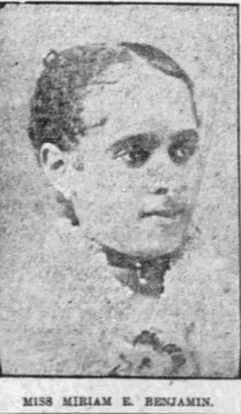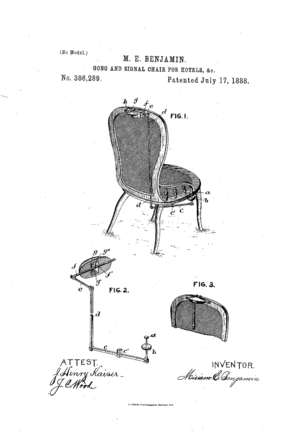Miriam Benjamin facts for kids
Quick facts for kids
Miriam E. Benjamin
|
|
|---|---|
 |
|
| Born |
Miriam Elizabeth Benjamin
September 16, 1861 |
| Died | 1947 (aged 85–86) |
| Nationality | American |
| Other names | E. B. Miriam |
| Occupation | Inventor Educator |
| Known for | Inventor of the Gong and Signal Chair and second black woman to receive a patent in the United States |
Miriam Elizabeth Benjamin (born September 16, 1861 – died 1947) was an American schoolteacher and a clever inventor. In 1888, she made history by getting a patent for her "Gong and Signal Chair for Hotels." This made her the second African-American woman to ever receive a patent in the United States!
Contents
Early Life and Learning
Miriam Benjamin was born in Charleston, South Carolina in 1861. She was the oldest of five children. In 1873, her family moved to Boston, Massachusetts. There, she went to the Girl's High School and finished in 1881. After school, she became a teacher at the Stanton Institute in Jacksonville, Florida.
While she was teaching, Miriam also studied at Howard University's medical school from 1894 to 1895. Later, she passed a tough government test. She worked as a clerk in different government offices. She also studied law and became an attorney.
Miriam Benjamin's Inventions
From 1888 to 1895, Miriam Benjamin taught in Washington, D.C.. This was in the city's separate school system. In 1888, she lived at 1736 New York Avenue, N.W. in Washington.
The Gong and Signal Chair
On July 17, 1888, Miriam got a patent for her famous invention. It was called the "Gong and Signal Chair for Hotels." This special chair had a bell (gong) and a signal light. When someone sitting in the chair pressed a small button, a bell would ring. Also, a red ball would show up on the back of the chair. This let an attendant know which guest needed help.
Miriam designed the chair to save money for hotels. It meant they wouldn't need as many waiters or attendants. It also stopped people from having to clap or shout for help. She believed it would make hotels quieter and more comfortable. She thought hotels could use half or even a third fewer staff.
Other Uses and Impact
Miriam also thought her invention could be useful in government buildings. She hoped it would be used in places like the United States House of Representatives. A similar, but more complex, system was put in place there in 1895. Her chair was also an early idea for the signal systems we see today. These are used on airplanes for passengers to call flight attendants.
In 1895, the Cotton States and International Exposition was held in Atlanta, Georgia. This big event showed off new products and technologies. It also encouraged trade. African-Americans were a big part of this Exposition. Booker T. Washington gave a very important speech there. The "Negro Building" at the Exposition showed inventions by African Americans. Miriam Benjamin's Gong and Signal Chair was one of them. People thought it could be used in hospitals or train stations. It would let patients or travelers call for help quietly.
More Inventions and Music
After her famous chair, Miriam kept inventing. When she moved back to Boston in 1900, she called herself a "solicitor of patents." This means she helped others get patents. In 1903, it was reported she patented a device for dressmaking. On December 4, 1917, she received another U.S. patent. This one was for a "Sole for Footwear." It was designed to help keep feet at a good temperature.
Miriam Benjamin also wrote music! She used the name E. B. Miriam for her musical pieces. These included songs and marches for piano and bands. In 1895, a magazine said her "Boston Elite Quickstep" march was very popular. It was even played by a famous band called Sousa's band. One of her songs was used in Theodore Roosevelt's presidential campaign in 1904.
In 1920, she returned to Boston. She lived and worked with her brother, Edgar P. Benjamin, who was also an attorney. Miriam was one of four African American women inventors of her time. These women created new technologies to help with things at home. Other inventors included Sarah Boone, Ellen Eglin, and Sarah E. Goode.
Family Life
Miriam Benjamin never got married. For most of her life, she lived with her mother, Eliza Jane Benjamin. Her brothers were also inventors and attorneys. Her brother Lyde Wilson Benjamin invented an improvement for "Broom Moisteners." Her younger brother, Edgar Pinkerton Benjamin, invented a "Trousers-Shield," which was like a bicycle clip. He also started a nursing home.
Miriam Benjamin passed away in 1947.
See also
 In Spanish: Miriam Benjamin para niños
In Spanish: Miriam Benjamin para niños
- List of African-American inventors and scientists
- Timeline of United States inventions


